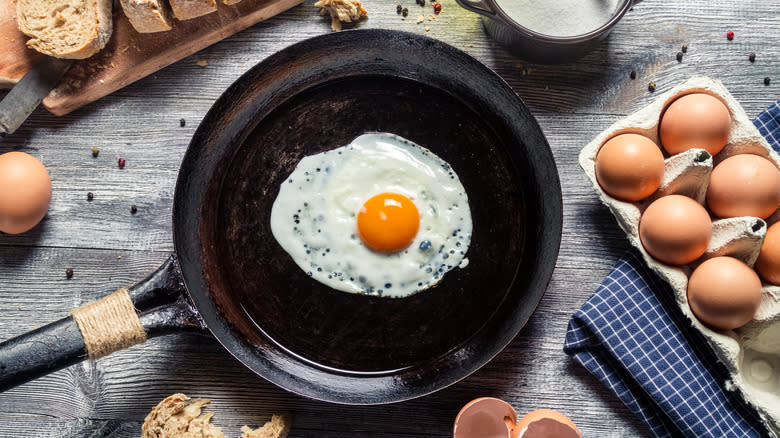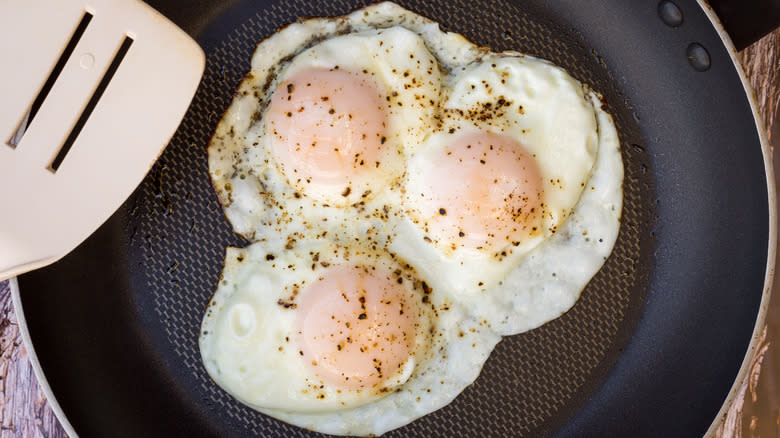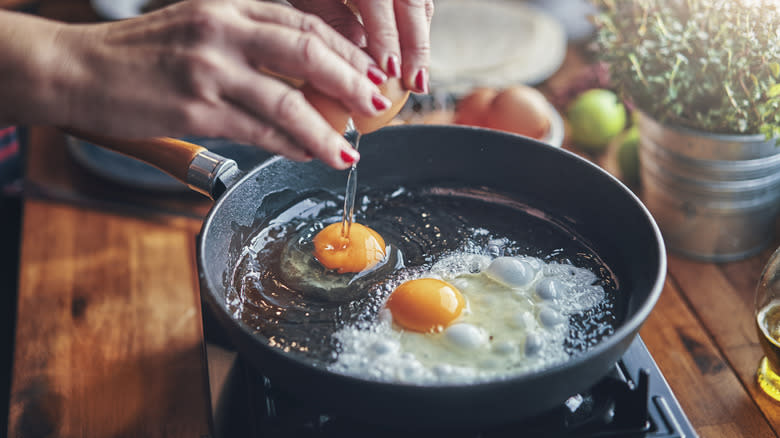The Pan Tip To Follow For Perfectly Cooked Over-Easy Eggs

We may receive a commission on purchases made from links.
Eggs might seem like an easy enough dish to cook, but in reality they're pretty delicate. A minute too short or too long leaves them burnt or under-done, and using the wrong pan means you'll end up soaking and scrubbing the pan after you're done with it. The first step to mastering eggs is not the cooking time; it's the pan. When you cook eggs over-easy, there are two criteria for the perfect egg pan: Make sure it's large enough so the eggs have room to cook, and make sure it is nonstick.
When preparing over-easy eggs, the yolks should remain fully liquid as you gently flip and cook them for very little time. Timing and pan size are essential in making sure your eggs come out over-easy (as opposed to over-medium or over-hard). If the yolks are too close together, they might not firm up enough. And if the pan isn't nonstick, you may quickly overcook the eggs while trying to scrape them off the bottom.
Read more: The 20 Best Egg Brands, Ranked
Make Sure Your Pan Is Large Enough - And Nonstick

You never want to cook eggs in a pan that's too small. The pan should be at least 8 inches in diameter, but 10 inches is the best option for two eggs. Eggs need room to spread out for them to cook evenly; a pan that's too small means they'll cook right on top of each other, which lessens the chances of even cooking and all but guarantees they'll fuse during the frying process -- and once that happens, it's hard to break them apart. If you're cooking more than two eggs, make sure the pan is at least 10 inches, and don't cook more than four at a time. 12-inch pans are an option if you plan to cook more than four eggs.
A nonstick frying pan is also a non-negotiable when making eggs. Most nonstick cookware is coated in something called PTFE, commonly known as Teflon, so this is an easy material to look for when deciding which pan to purchase. You can also use an uncoated, naturally nonstick material. If you own a cast iron skillet, it's not just for getting a golden sear on your meat -- it also makes for a great egg pan.
Extra Steps For Cooking Perfect Over-Easy Eggs

In addition to choosing the right pan, you can make the process even more fluid by adding cooking spray or butter to the pan before cracking the eggs. Both create an extra nonstick layer, making the process of flipping and removing the eggs even easier. Salted butter will add much more flavor to the eggs than cooking spray.
Eggs will lift easily from the pan when the underside is completely firm. When cooking over-easy eggs, they only need about two minutes on low heat, which will better control how quickly the eggs cook. After two minutes, gently slide a wide spatula (or a fish spatula) under the eggs and lift slowly to make sure the egg whites have set before fully flipping. The eggs will be done after no more than 30 seconds on the flipped side, so be careful not to overcook them. Then, either remove them carefully with a wide spatula -- which is better for keeping the eggs intact -- or slide them off the pan onto your plate and serve immediately.
Read the original article on Daily Meal.

